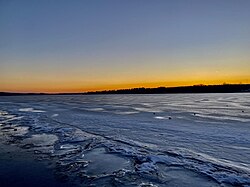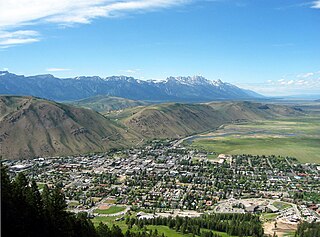
Jackson is a town in Teton County, Wyoming, United States. The population was 10,760 at the 2020 census, up from 9,577 in 2010. It is the largest town in Teton County and its county seat. Jackson is the principal town of the Jackson, WY-ID Micropolitan Statistical Area, which includes Teton County in Wyoming and Teton County in Idaho. The town, often familiarly or mistakenly called Jackson Hole, derives its name from the valley in which it is located. Jackson is a popular tourist destination due to its proximity to the ski resorts Jackson Hole Mountain, Snow King Mountain, and Grand Targhee, as well as Grand Teton National Park and Yellowstone National Park.

Fort Bridger was originally a 19th-century fur trading outpost established in 1842, on Blacks Fork of the Green River, in what is now Uinta County, Wyoming, United States. It became a vital resupply point for wagon trains on the Oregon Trail, California Trail, and Mormon Trail. The Army established a military post here in 1858 during the Utah War, until it was finally closed in 1890. A small town, Fort Bridger, Wyoming, remains near the fort and takes its name from it.

The jackalope is a mythical animal of North American folklore described as a jackrabbit with antelope horns. The word jackalope is a portmanteau of jackrabbit and antelope. Many jackalope taxidermy mounts, including the original, are made with deer antlers.
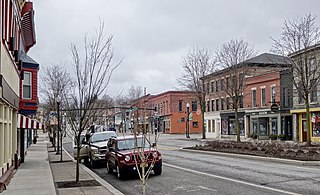
Perry is a village in the towns of Perry and Castile in Wyoming County, New York, United States. The population was 3,673 at the 2010 census. The village is at the junction of state routes 39 and 246.

Perry is a town in Wyoming County, New York, United States. The population was 5,813 at the 2020 census. The town is named after Commodore Oliver Hazard Perry.

Petit Jean State Park is a 3,471-acre (1,405 ha) park in Conway County, Arkansas managed by the Arkansas Department of Parks and Tourism. It is located atop Petit Jean Mountain adjacent to the Arkansas River in the area between the Ouachita Mountains and Ozark Plateaus.

In American folklore, Champ or Champy is the name of a lake monster said to live in Lake Champlain, a 125-mile (201 km)-long body of fresh water shared by New York and Vermont, with a portion extending into Quebec, Canada. The legend of the monster is considered a draw for tourism in the Burlington, Vermont and Plattsburgh, New York areas.

Piedmont is a ghost town located in Unita County, Wyoming, United States. It was once a thriving small railroad and timber town, but started to decline when Union Pacific opened a new line that bypassed the town.

Serpent Mounds Park is a sacred and historical place located near Keene, Ontario, Canada. Serpent Mounds operated as a provincial park, established in 1955 through a lease with the Hiawatha First Nation, of the Michi Saagiig. In 1982, while operating as a provincial park the mounds were designated a National Historic Site, including East Sugar Island.
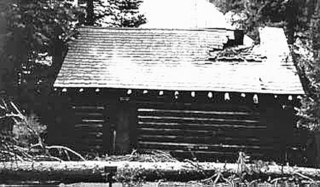
The Death Canyon Barn is a combination barn and ranger patrol cabin in Grand Teton National Park. The barn was built in Death Canyon on the Death Canyon Trail at its junction with the Alaska Basin Trail by the Civilian Conservation Corps in 1935 in the National Park Service rustic style. Located with a clear view of Prospector Mountain, it shares a common style and purpose with the Cascade Canyon Barn to the north in the park, with minor differences attributable to available materials and the preferences of the work crews building the barns.
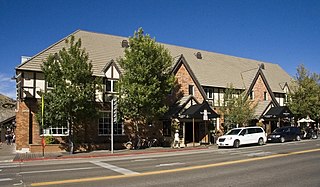
The Wort Hotel was built in downtown Jackson, Wyoming, United States by brothers John and Jess Wort, who were significant figures in the transformation of the economy of Jackson Hole from ranching to tourism. The somewhat Tudor-style building was the first luxury hotel in Jackson. The two-story building features brick facing, with half-timbering and stucco on the second floor and a series of gables facing the street.

The Anderson Lodge or Anderson Studio was built in 1890 in the Absaroka Mountains west of Meeteetse, Wyoming, in what was then the Yellowstone Park Timber Land Reserve, soon renamed the Yellowstone Forest Reserve. The two-story rustic log structure became the home of rancher and artist Abraham Archibald Anderson from 1901 to 1905. Anderson played a significant role in the development of the forest reserve as Special Superintendent of Forest Reserves, and the Anderson Lodge was used as an administrative building for the forest.

The Riddle Brothers Ranch is a pioneer ranch complex located in the Steens Mountain Cooperative Management and Protection Area in Harney County in eastern Oregon, United States. It is a rare extant example of the small family ranch. The ranch is located on both sides of the Little Blitzen River on public land and is administered by the Bureau of Land Management.

The Fossil Cabin near Medicine Bow, Wyoming, United States, was built in 1932 as a roadside attraction. The cabin is built of dinosaur bones excavated at nearby Como Bluff, using a total of 5,796 bones. The cabin was built as part of a gasoline filling station along US 30 by Thomas Boylan. Boylan had come from California to homestead in Wyoming and had been collecting bones for seventeen years, intending to create sculptures of dinosaurs in front of his house and gas station along the Lincoln Highway.

Epworth Hall is a historic assembly hall located in Castile township in Wyoming County, New York. It was built in 1892 in the Colonial Revival style and is the largest of three such halls on the grounds of the Silver Lake Institute, a Methodist-affiliated camp facility established in 1873. The two story, 100 feet by 50 feet, multi-purpose building exhibits elements of the Akron Plan in its interior layout.

The Trapps Mountain Hamlet Historic District is located on the Shawangunk Ridge in Gardiner, New York, United States. It is a large area that covers the site of a settlement that thrived there from the late 18th to mid-20th centuries. Inhabitants practiced subsistence farming, making it one of the rare such communities in the East to have left any trace remaining. They supplemented that with a variety of other trades, primarily in the forest products industry, with most inhabitants gradually coming to work at nearby mountain resorts in the 20th century. The last resident died in 1956.

Concordia Log Cabin College is a historic site in Altenburg, in Perry County, Missouri. The structure is a log building under a protective shelter situated in the Trinity Lutheran Church maple grove. It served as the first college for the Lutheran Church–Missouri Synod and was first Lutheran college west of the Mississippi River. Today, it commemorates the German Lutheran migration of 1838–1839 and the founding of the Lutheran Church–Missouri Synod, and features two log cabins from that era. The building was listed on the National Register of Historic Places in 1978.
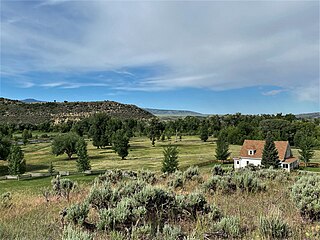
The Stone Wall Ranch, also known as the Reader or Rasmussen Ranch, is a ranch in the Little Snake River valley of Carbon County, Wyoming, about 1.5 miles (2.4 km) from Savery. It was established by Noah and Hosannah Reader in 1871, the first permanent homestead in the valley. A temporary winter shelter was built in the winter of 1871-72, followed by a permanent structure in 1872-73 that survives in the ranch complex. The ranch was named for a nearby sandstone escarpment.
The CM Ranch and Simpson Lake Cabins are separate components of a single historic district associated with Charles Cornell Moore, a Fremont County, Wyoming dude ranch operator. The CM ranch, named after Moore, operated as a dude ranch from 1920 to 1942 and resumed operating in 1945. The Simpson Lake Cabins were purchased by Moore in 1931 and were operated as a hunting camp, continuing until 1997 when the CM ranch was sold to new owners and the Simpson Lake property was taken over by the U.S. Forest Service.. The sites are separated by 13 miles (21 km).
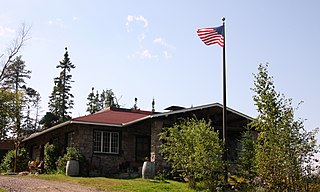
Chik Wauk Lodge, now Chik-Wauk Museum and Nature Center, is a historic building near the northern terminus of the Gunflint Trail northwest of Grand Marais, Minnesota, United States. It overlooks Saganaga Lake.
